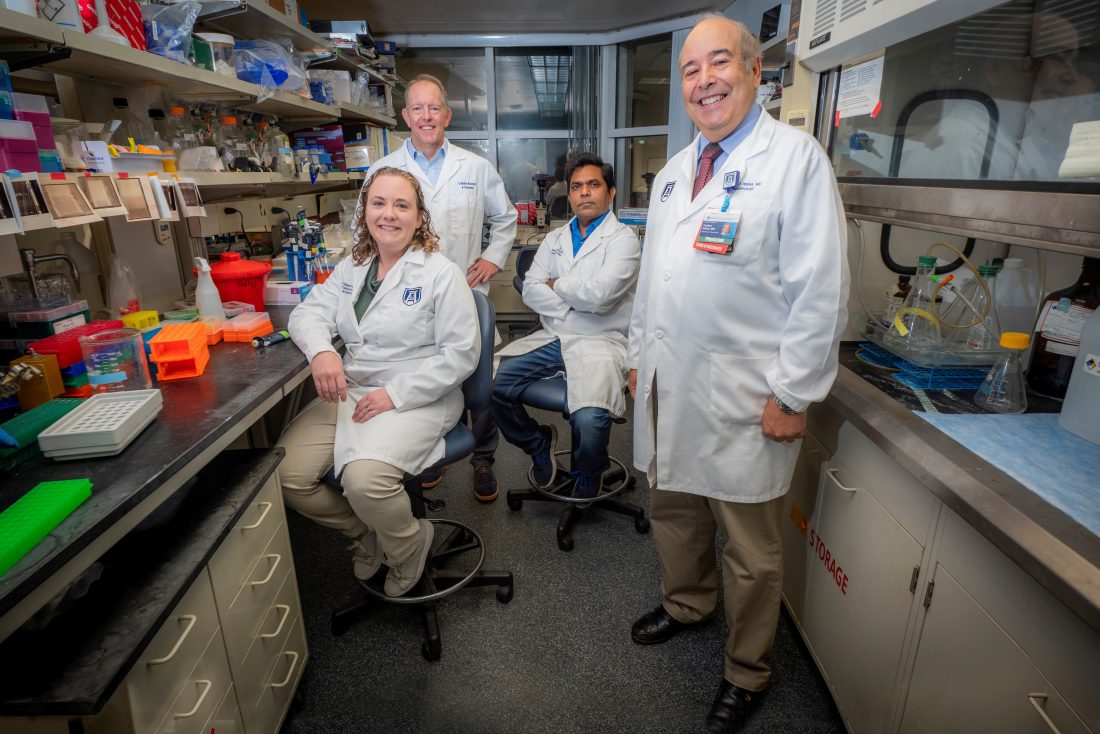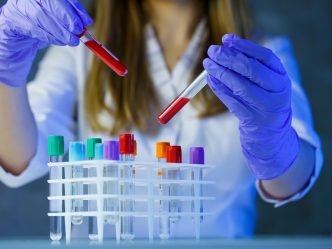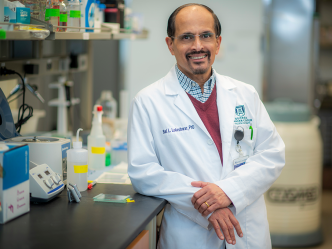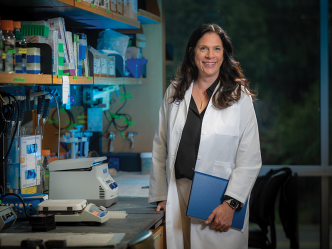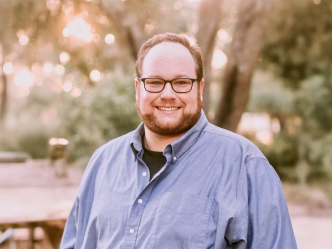The conversations between our bone and muscle change as we age, and both are the weaker for it, Medical College of Georgia scientists say.
They are leading a five-year, $11 million initiative (PO1AGO36675) funded by the National Institutes of Health to keep the conversation, our bone and muscle and ultimately us stronger longer.
The bone and muscle that keep us upright are in constant communication and their wellbeing tends to go hand in hand, says Carlos Isales, MD, chief of the MCG Division of Endocrinology, Diabetes and Metabolism and co-director of the Center for Healthy Aging. Muscle loss, or sarcopenia, is a major cause of falls, and falls are a major cause of bone fractures, including common and potentially debilitating hip fractures.
Isales; Mark Hamrick, PhD, bone and muscle biologist and co-director of the Center for Healthy Aging; Sadanand Fulzele, PhD, aging researcher in the Department of Medicine; and Meghan McGee-Lawrence, PhD, a biomedical engineer in the Department of Cellular Biology and Anatomy, are principal investigators on the re-renewal of the NIH Program Project grant that will identify early, optimal points for novel interventions to change this dynamic in an aging population that is exploding with all 73 million baby boomers reaching age 65 by 2030.
Early in the complex biological dynamic than can go awry with age is tryptophan, an essential amino acid many of us associate with making us sleepy after a big turkey dinner. But Isales calls tryptophan “an important centerpiece of metabolism,” which helps us produce and maintain important proteins, enzymes even neurotransmitters that enable brain cells to communicate with each other and other cell types, like the constant communication between our brain and body so we can flex our muscles and move our legs.
Throughout life, the natural enzyme, indoleamine 2,3-dioxygenase 1, likely better known for its role in tamping down inflammation, breaks tryptophan down into usable products like kynurenine and picolinic acid, which are known to have an important role in the production of fuel for our cell powerhouses, or mitochondria.
But as with so many natural functions, with time the relationship becomes unbalanced. Our tryptophan levels tend to drop, while levels of IDO1 tend to rise.
Higher IDO1 levels mean more of the available tryptophan gets converted to kynurenine, which is now more likely to hook up with the aryl hydrocarbon receptor, or AhR, already associated with stiff, aging blood vessels in mice and humans. This connection means kynurenine instead damages cell powerhouses, increases inflammation and generally ages muscle and bone.
“You have inflammation which ramps up IDO1, which is now shunting all that tryptophan toward a kynurenine pathway, which also contributes to depression, Alzheimer’s and cardiovascular disease,” Hamrick says, running down the list of other conditions that tend to increase with age.
“Both of these systems are not designed for people to live into their 100s,” Isales notes, and instead become ingredients of a recipe for disaster. The MCG team was among the first to explore how the ingredients unfold in aging muscle and bone, while others studying cancer first connected kynurenine to AhR and the potential bad consequences.
In bone and muscle, the MCG scientists say the receptor’s activation by kynurenine drives up destructive oxidative stress, which damages the powerhouses, which makes bone and muscle weak because cells don’t have the energy they need. “That is our idea,” Hamrick says.
“If we can prevent activation of AhR, we can prevent some of the bad things we have seen happen downstream,” McGee-Lawrence says, noting the drugs they are using for these studies were designed to inhibit the receptor in cancer.
They are examining the impact of inhibitors of IDO1 as well, which also are in clinical trials for cancer. Additionally, they are taking each of these key players out of the equation through genetic manipulation to both further elucidate their role in this aging scenario and identify the best place to intervene.
The bottom line could mean that treatment of bone might help restore the health of muscle and/or vice versa, by helping restore healthier conversations between the two, Hamrick says. In fact, a class of existing drugs called bisphosphonates, which hone in to bone and today are widely used to treat osteoporosis, might be a good mechanism to deliver additional, targeted treatment, he says.
A project led by Hamrick and Isales is testing their hypothesis that making less kynurenine available or inhibiting AhR signaling should be a good therapy strategy. They are knocking out IDO, which converts tryptophan to kynurenine, in bone or muscle and doing the same thing with the AhR, which kynurenine activates, then looking at the impact on bone and muscle health as mice grow old.
To enhance the good kynurenine can do, like keeping aging stem cells focused on making bone and muscle, they also are giving some of its beneficial metabolites to aged mice with the idea that the age-related damage to bone and muscle can be reversed and that the right cocktail of these metabolites could soon be a good dietary intervention to better protect bone and muscle.
Those cocktails likely also will include tryptophan, because of its many positive contributions like making more melatonin, important to sleep, and more of the neurotransmitter serotonin, important for a myriad of functions like attention, behavior and breathing.
Isales and Hamrick also are further exploring the clearly destructive pairing of kynurenine and AhR. The scientific team has evidence kynurenine increases significantly with age in humans and that those high levels are associated with frailty. They’ve shown in the lab that kynurenine induces muscle wasting and increases accumulation of damaging reactive oxygen species, or ROS, in muscle cells, which leads to cell senescence, and that inhibiting AhR reduces these consequences while inhibiting AhR or IDO with drugs improves muscle strength in aged mice.
Fulzele’s project is working to better piece together how kynurenine’s interaction with AhR impacts mitophagy, a natural degradation of our cell powerhouses meant to essentially “take out the trash” by eliminating nonfunctioning parts, Fulzele says, and help mitochondria continue to function at a premium.
All cells have mitochondria and some cells, like our ideally active muscle cells, have a lot of them. It’s been shown that suppressing the degradation of tryptophan and consequently how much kynurenine accumulates increases the lifespan of flies, worms and bats. “With age there is mitochondrial dysfunction and kynurenine is one of the factors,” Fulzele says.
He’s also looking at related senescence of the stem cells that in our youth more readily produce bone and muscle to help keep both strong. Senescent cells are not dead, just less active, particularly when it comes to their ability to divide, which can be a good thing when it comes to cancer. But these less-active cells also are considered a hallmark of aging and some therapies even target their elimination as an antiaging strategy. And, their damage can spread as senescent cells secrete numerous proinflammatory factors that can affect their neighbor cells and the body, Fulzele says.
With all eyes on a clinical scenario that is preventative, he is giving IDO inhibitors to mice that are equivalent to 50-something-year-old humans, which should reduce kynurenine levels and help restore healthy levels of mitophagy and prevent premature senescence. The treatment is being given twice daily for three months, a long time in mouse years, then Fulzele will look at the impact on bone and muscle. To also help identify the best point of intervention, he’s taking a similar approach in giving the AhR inhibitors.
McGee-Lawrence is focusing on understanding gender differences in bone loss, because while osteoporosis affects both males and females, it is more prevalent in females. The sex hormone estrogen is key to bone health, and females are generally considered at higher risk for osteoporosis with age because estrogen levels drop significantly at menopause. The scientists have evidence that kynurenine also plays a roll in the sex differences by having a more deleterious impact on the bone-forming osteoblasts of females.
So, McGee-Lawrence’s team is looking at the impact of estrogen as well as glucocorticoids, steroid hormones that naturally reduce inflammation. Glucocorticoid receptors and estrogen receptors are in the same large family of receptors called cell nucleus receptors involved in regulating a lot of important physiological functions like reproduction and inflammation. They suspect and have evidence that the altered communication between kynurenine and AhR and subsequent communication with receptors for estrogen and glucocorticoids are behind this disproportionate impact in females.
Her lab also is developing a mouse where AhR is knocked out specifically in bone and Hamrick’s lab is doing the same thing in muscle to better understand the individual impact and whether, as they suspect, improving the health of one will help the other.
Because kynurenine is what induces the bone-eating osteoclasts, either of the scientists’ current intervention points — IDO or AhR — would work before the point of action for the commonly used bisphosphonates for osteoporosis, which work to normalize the process of bone being made by osteoblasts and broken down by osteoclasts. But as Hamrick noted, they could also likely be used synergistically with decades’ old bisphosphonates.
“We are focused on increasing healthspan,” Isales says of group’s emphasis on living healthier, not just more years. “By keeping your muscle and your bone healthy, that helps you stay active longer,” says McGee-Lawrence. “By staying active longer, you can increase your healthspan, which means we may not be able to help people live longer necessarily but we can help them stay healthier for longer.”
NAD+, or nicotinamide adenine dinucleotide, which kynurenine does such a good job helping us make when we are younger, is intrinsically used by the powerhouses of cells to make energy so cells can function optimally and a huge area of focus in aging research.
Because tryptophan is an essential amino acid, we have to consume it because our bodies don’t produce it. While most of us likely think about turkey being high in tryptophan, whole milk and tuna are right up there with poultry and so are oats, cheese and nuts. Tryptophan circulates at the lowest concentration of the eight essential amino acids, but it has the most breakdown products, called metabolites, Isales says.
David Munn, MD, pediatric oncologist and co-director of the MCG Pediatric Immunotherapy Program, and Andrew Mellor, PhD, former MCG immunologist, reported in 1998 in the journal Science that the fetus uses IDO to help avoid rejection by the mother’s immune system. They soon learned that tumors use IDO for protection as well and worked with NewLink Genetics to develop one of the first IDO inhibitors in the early 2000s. The IDO inhibitor they helped develop is now under study in children with cancer at the Georgia Cancer Center and Children’s Hospital of Georgia.
 Augusta University
Augusta University
